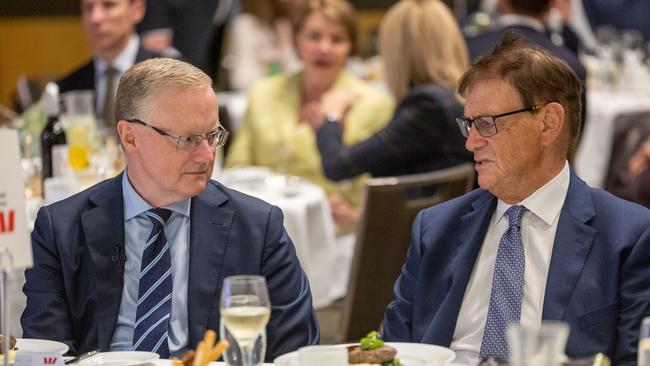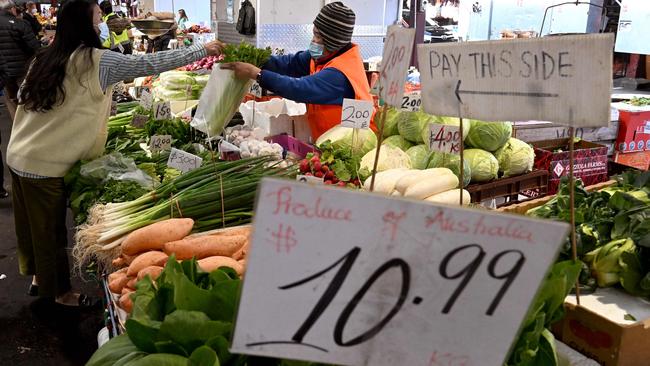RBA’s quarterly statement shows optimism for a soft landing
The RBA is less hawkish on the interest rate outlook although some economists question the assumptions behind its forecasts.

The Reserve Bank has forecast a soft landing for the Australian economy, albeit with some optimistic assumptions on inflation, productivity and interest rates.
After sinking to a downwardly-revised pace of 0.9 per cent at the end of 2023, the nation’s economic growth rate is expected to rebound steadily to 2.3 per cent by the end of 2025.
Despite the most aggressive tightening of monetary policy in three decades, the unemployment rate – recently around 3.6 per cent – isn’t expected to exceed 4.5 per cent. That’s even with inflation tipped to fall back to 2.8 per cent in late 2025, which is within the central bank’s 2-3 per cent target band.
The RBA has increased its cash rate target from a record low of 0.1 per cent to a decade high of 4.1 per cent since May 2022 as it struggles to rein in a post-pandemic surge in prices which has pushed Australia’s CPI inflation rate above the central bank’s target band for the past two years.
In its quarterly Statement on Monetary Policy (SOMP) for August, the bank was more sanguine about the risks associated with inflation remaining above its target band for another two years.
“The board’s current assessment is that the risks around the inflation outlook are broadly balanced,” the statement said.

“But it recognises that the crystallisation of upside risks would increase the likelihood of inflation staying high for longer and a rise in medium-term inflation expectations.”
The RBA cautioned that if inflation expectations were to rise, it would require “even higher interest rates, a bigger economic slowdown and a larger rise in unemployment to bring inflation back to target”.
Medium-term inflation expectations remained consistent with inflation returning to the target band, but core inflation had been “stickier than anticipated” overseas, the RBA noted.
It said monetary policy rates overseas were “generally at a higher level than the cash rate in Australia, yet Australia’s inflation rate is at least as high” and these factors “highlight the risk that inflation could be above the target range for an even longer period than currently forecast, which would increase the probability of higher inflation expectations becoming embedded.
“Tightening policy further could provide some further insurance against these upside risks to inflation.”
Its latest forecasts depend on a path for the cash rate broadly in line with expectations derived from surveys of professional economists and financial market pricing.
The cash rate was assumed to rise by a further 15 basis points to a peak around 4.25 per cent before declining to around 3.25 per cent by the end of 2025.
The rate of population growth was revised higher in the near term but was expected to gradually decline to around its pre-pandemic average.
However, it said “monetary policy has been tightened significantly in a relatively short period and that the level of the cash rate is restricting economic activity”.
That was in line with the minutes of the July board meeting, which said: “The stance of monetary policy was clearly restrictive at the prevailing cash rate.”
It again noted that “growth in the economy has slowed and policy is working to establish a better balance of supply and demand in the economy and thus to bring inflation down”.

“The data in recent months have confirmed that inflation is moving in the right direction and is consistent with inflation returning to the 2-3 per cent target range over the forecast period,” it said.
However, while the RBA appeared less hawkish on the interest rate outlook, some economists cautioned that its forecasts rested on some optimistic forecasting assumptions.
“Against the backdrop of a similar global central banking narrative, today’s SOMP will do little to shift expectations that this policy cycle is drawing to an end, if not already there,” said RBC Australia chief economist Su-Lin Ong.
“While that may be the case, we caution that the RBA’s inflation forecasts assume labour productivity growth, which is currently very weak, will return to its pre-pandemic trend over the next year or so, which seems to us particularly optimistic.”
The RBA’s comments about the stickiness of core services inflation in comparable economies and the fact that their policy rates are generally higher than Australia’s, even though the nation’s inflation rate is at least as high, raises the question of whether policy settings in countries such as the US, Britain, Canada and New Zealand are too high, or Australia’s are too low, according to Ms Ong.
NAB said the RBA forecasts of core trimmed mean yearly inflation at 3.9 per cent by the end of 2023, implied that it saw 3Q and 4Q 2023 trimmed mean inflation averaging 0.85 per cent quarterly, which was “too conservative” given the award and minimum wage increases, higher energy costs, plus some looming large price increases for some other service categories.
“It appears the RBA has based the near-term forecasts off the latest CPI data, which leaves them heavily exposed should Q3 CPI print high as we expect,” said NAB head of market economics, Tapas Strickland. “That suggests there remains a real risk that the RBA is not quite done yet, and NAB continues to see the RBA lifting the cash rate again in November to 4.35 per cent.”
Westpac chief economist Bill Evans said the RBA board “seems relaxed” about the fact that its forecasts don’t have inflation reaching the midpoint of its target band “although such an approach has many critics.”
The RBA’s assessment that inflation risks were now “evenly balanced” had boosted the case for steady interest rates, Mr Evans said.




To join the conversation, please log in. Don't have an account? Register
Join the conversation, you are commenting as Logout